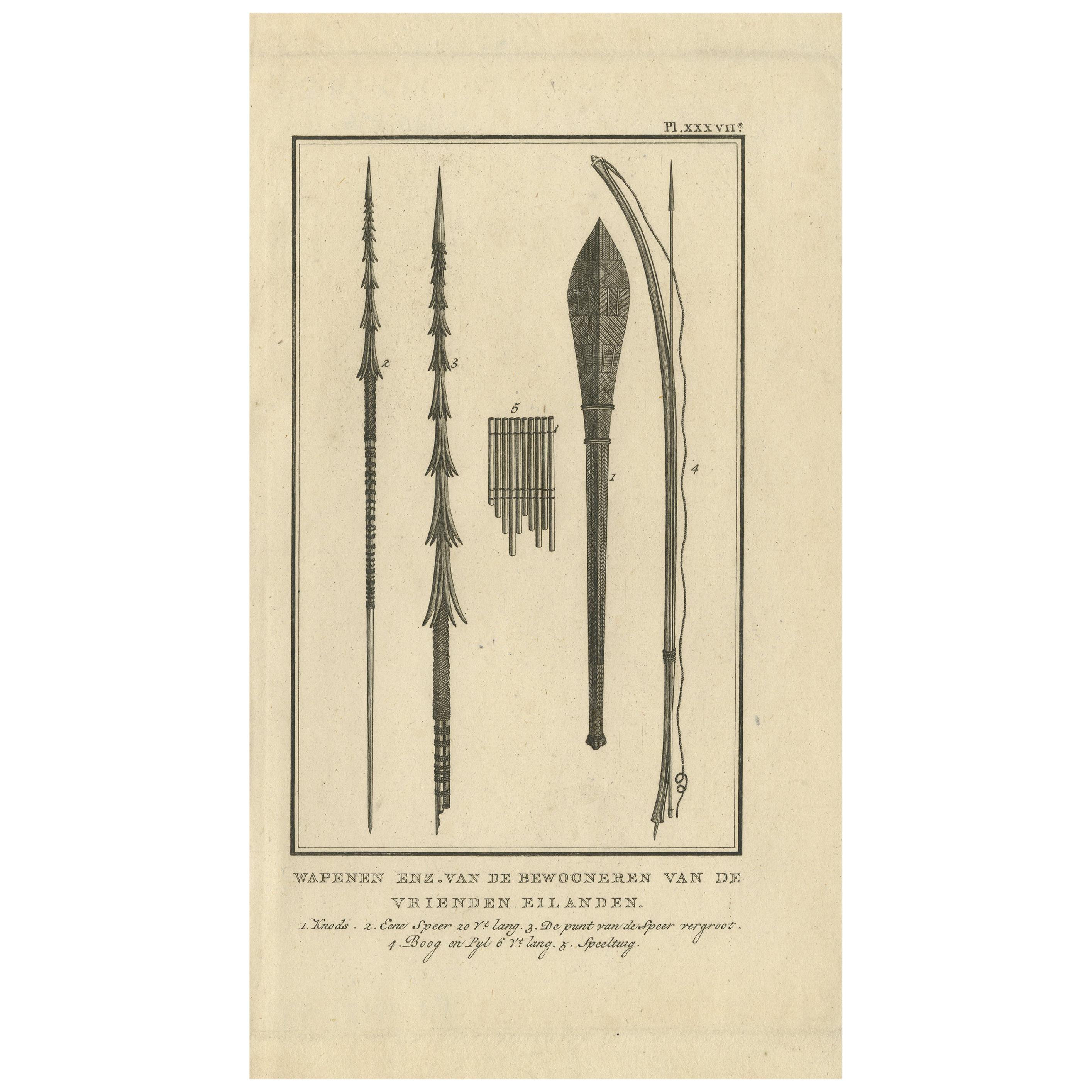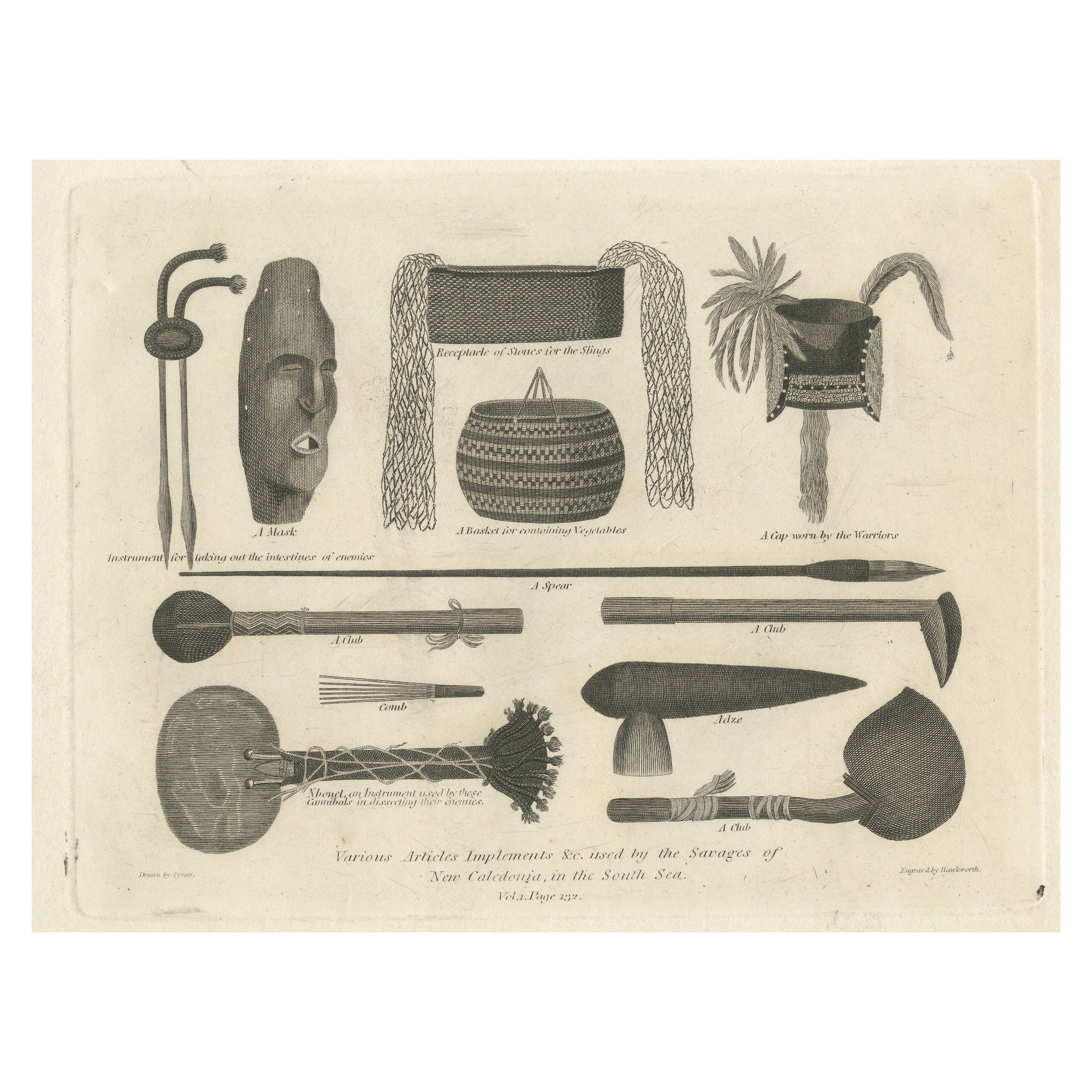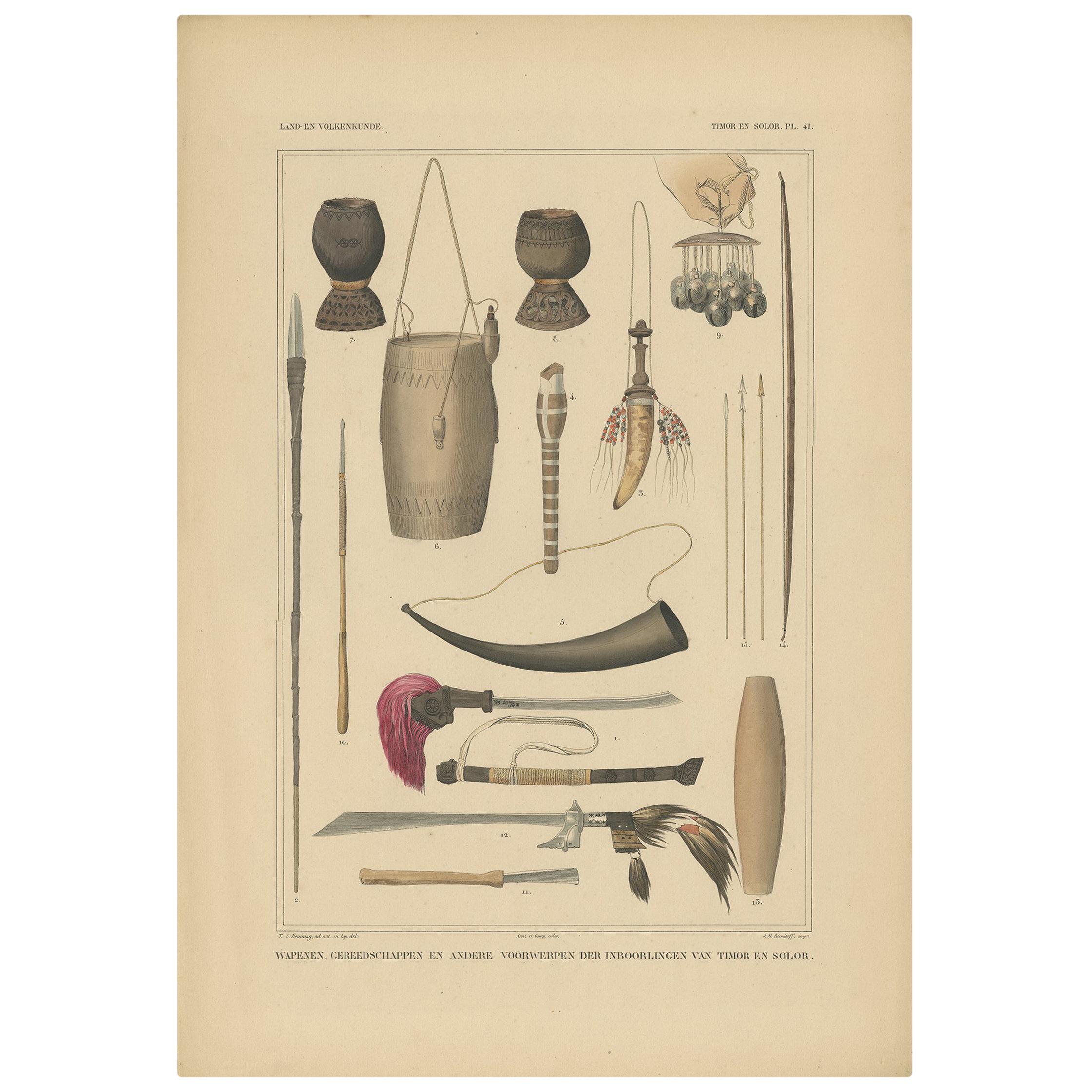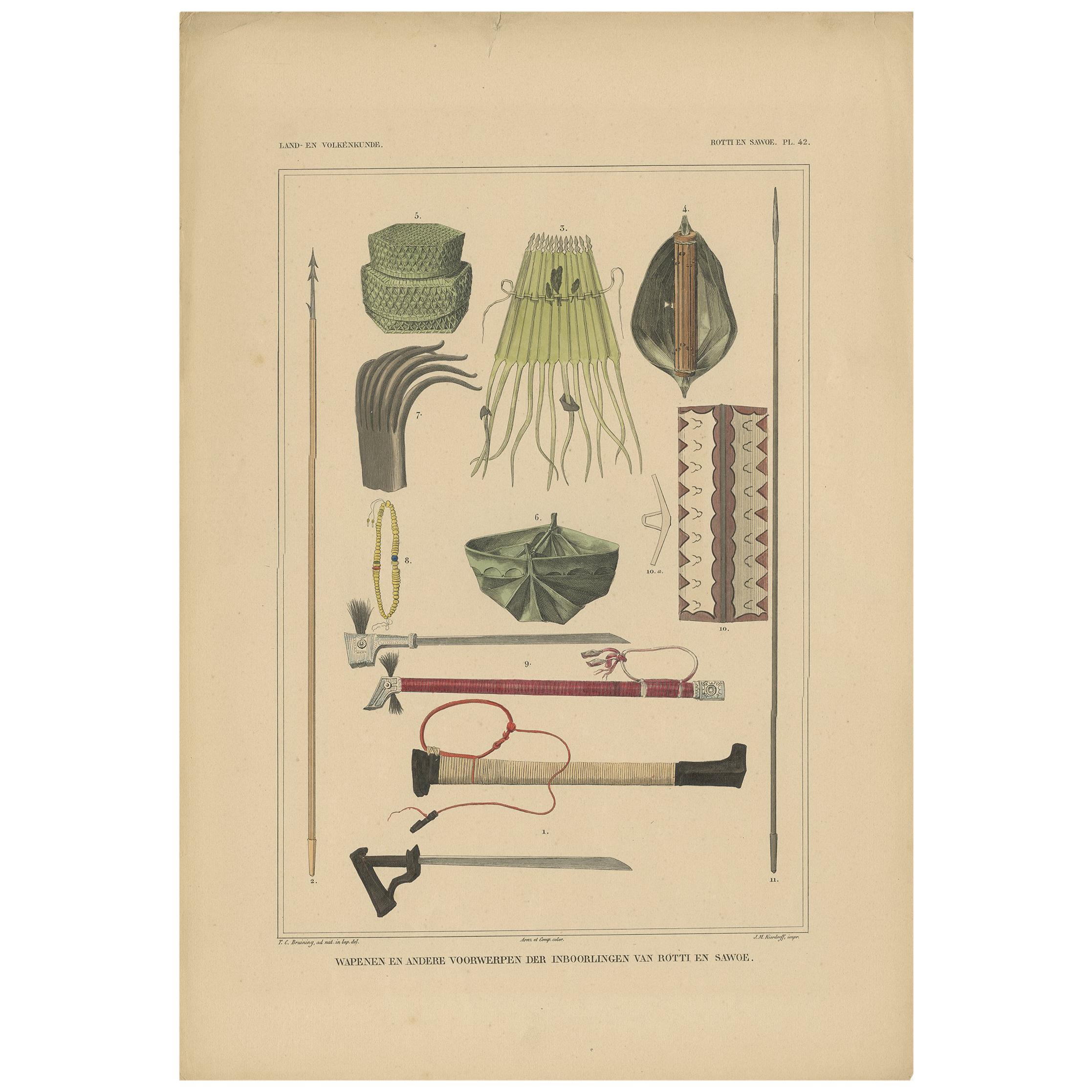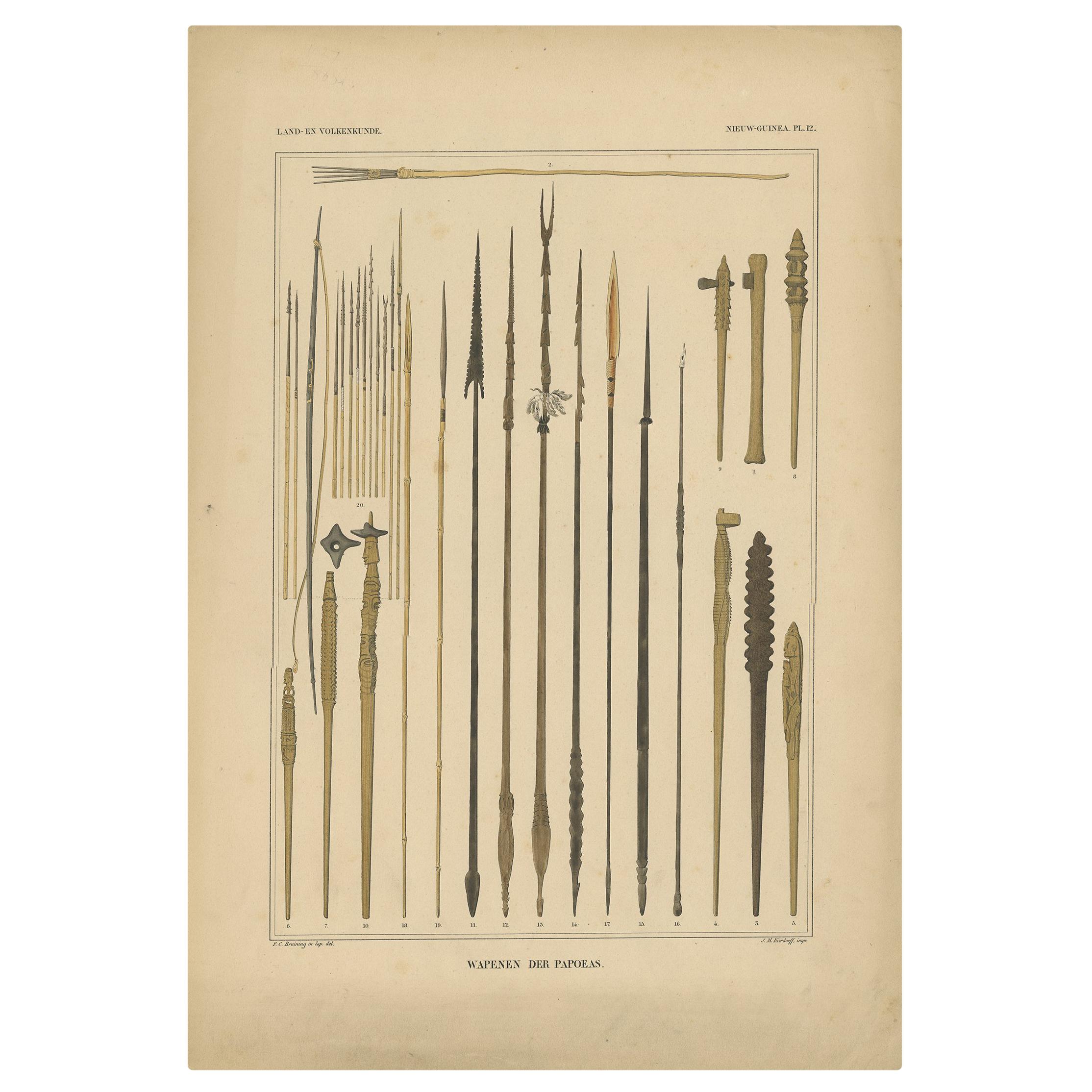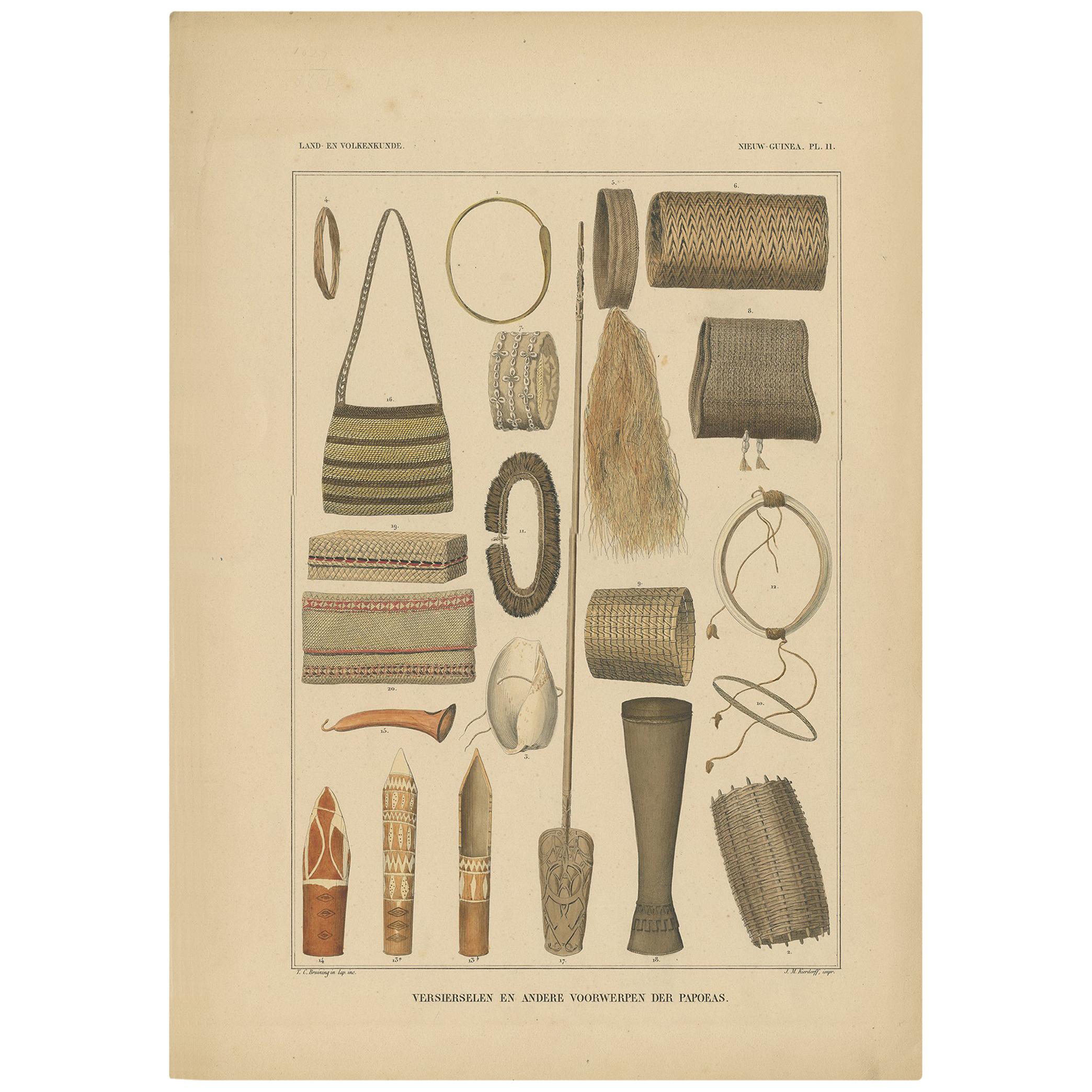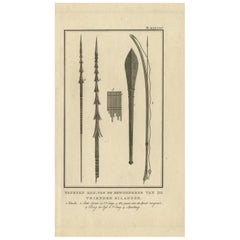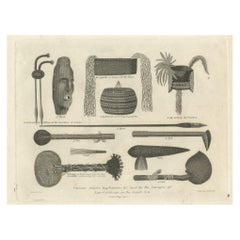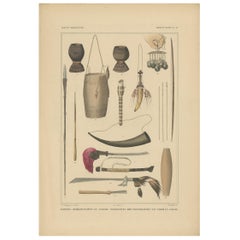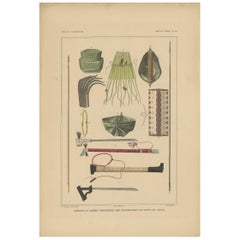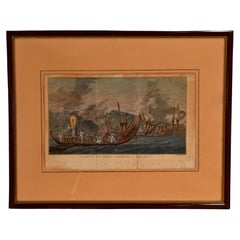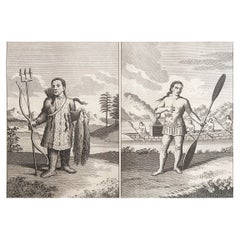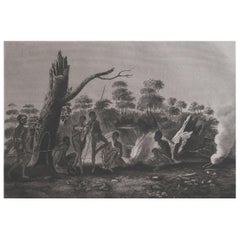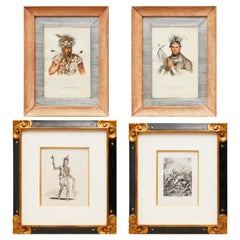Items Similar to 1777 Engraving of Tongan Weapons & Artifacts from Captain Cook's Third Voyage
Want more images or videos?
Request additional images or videos from the seller
1 of 9
1777 Engraving of Tongan Weapons & Artifacts from Captain Cook's Third Voyage
$267.92
$334.9020% Off
£199.27
£249.0920% Off
€224
€28020% Off
CA$374.18
CA$467.7320% Off
A$406.08
A$507.6020% Off
CHF 213.66
CHF 267.0820% Off
MX$4,933.90
MX$6,167.3820% Off
NOK 2,675.02
NOK 3,343.7720% Off
SEK 2,518.77
SEK 3,148.4620% Off
DKK 1,705.96
DKK 2,132.4520% Off
About the Item
This print titled "Ornemens, Ustensiles Et Armes Des Isles Des Amis" is from Captain James Cook's third voyage, specifically published in 1777 by Strahan and Cadell. It represents various weapons, decorations, and utensils from the Tonga Islands (referred to as "Isles des Amis" in French). The copper-plate engraving, produced by Chapman (Del.) and Record (Sculp.), is part of an original collection of prints from *Voyage dans L’Hémisphère Austral et Autour du Monde*, a French edition of Cook's journals. The voyage occurred from 1776 to 1779, marking Cook's third and final voyage.
This particular illustration, "No. XXI," shows intricately designed objects, including tools, woven bags, spears, and other items used by the Tongan people, beautifully capturing the craftsmanship and cultural artifacts encountered during the expedition.
This 1777 engraving, titled *Ornemens, Ustensiles Et Armes Des Isles Des Amis*, provides a fascinating glimpse into the material culture of the Tonga Islands, referred to as "Isles des Amis" in the French edition of Captain James Cook's third voyage (1776–1779). Cook's exploration of the Pacific included visits to the Tonga Islands, and the items depicted in this engraving reflect both functional and aesthetic aspects of Tongan life.
### Detailed Analysis of the Items Depicted:
1. Weapons (Spears and Clubs):
The engraving features spears and clubs, which were essential for both hunting and warfare. The intricate designs on the spears, particularly the details on the tips and shafts, demonstrate the advanced craftsmanship of the Tongan people. Some of these weapons may have also held ritual or ceremonial significance, indicating their cultural importance beyond practical use.
2. Woven Baskets:
The two baskets shown in the engraving are skillfully woven, with complex geometric patterns and bright colors. These baskets were likely used for storage, but their detailed designs suggest that they also had aesthetic value. The weaving traditions of Tonga are emphasized here, showcasing the artistry involved in creating such practical yet beautiful items.
3. Fishhooks and Lures:
The fishing tools, including what appears to be a hook or lure, highlight the importance of fishing in Tongan society. The design of these items reflects the islanders' deep knowledge of their marine environment and their expertise in crafting tools specifically suited for local conditions. Fishing was a vital aspect of daily life, and these items were critical for sustenance.
4. Decorative Objects and Utensils:
The inclusion of a reed panpipe suggests that music played a role in Tongan culture. This musical instrument reflects broader social and cultural practices, where music and communal gatherings were likely significant. Other small items shown in the engraving could serve decorative or ritualistic purposes, indicating the complexity of Tongan cultural life.
### Context in Captain Cook's Third Voyage:
This engraving comes from one of the most significant periods of European exploration in the Pacific, led by Captain James Cook. During his third voyage, Cook's team encountered the people of the Tonga Islands, and the items in this engraving represent the material culture they observed. The objects depicted were carefully selected to convey a sense of the everyday life and craftsmanship of the Tongan people to a European audience.
The print was created as part of the official publication of Cook’s journals and accompanied his written accounts of the Pacific Islands. These publications were immensely popular in Europe, and the engravings allowed readers to visually engage with the exotic items described in the texts. The high level of detail in the engraving was meant to ensure accuracy and to satisfy the curiosity of Europeans eager to learn about distant lands.
This particular engraving was published by Thomas Cadell and William Strahan, who were prominent figures in the London print and publishing industry. Their involvement in producing and disseminating Cook's journals helped spread knowledge of the Pacific to a wide European audience, contributing to the growing interest in ethnography and exploration.
### Artistic and Historical Significance:
1. Ethnographic Importance:
The engraving is an early example of ethnographic documentation, recording not just the objects but also the culture of the Pacific Islanders. These prints offered European audiences a rare visual insight into cultures that were previously unknown to them.
2. Cultural Exchange:
The baskets, musical instruments, and other objects in the engraving highlight the richness of Tongan craftsmanship and the cultural exchanges that took place during Cook's voyage. These objects were symbols of the interactions between Europeans and indigenous peoples, showcasing both the uniqueness and the universality of human creativity.
3. Printmaking and Distribution:
The engraving, produced using copper-plate techniques, allowed for high levels of detail and could be widely reproduced. This ensured that the images reached a large audience and helped to shape European perceptions of the Pacific. The collaboration between Chapman (the artist) and Record (the engraver) resulted in a work that not only documented the objects but also conveyed their cultural significance with precision and artistry.
In conclusion, this engraving offers a rich perspective on Tongan material culture during the late 18th century, providing valuable insights into both the daily life and the artistic traditions of the islands. It also represents a key moment in the history of European exploration and the growing field of ethnography.
- Dimensions:Height: 10.83 in (27.5 cm)Width: 16.54 in (42 cm)Depth: 0.01 in (0.2 mm)
- Materials and Techniques:Paper,Engraved
- Period:1770-1779
- Date of Manufacture:1777
- Condition:Good condition. Original hand-colouring. Overall light foxing. Vertical fold as published. General age-related toning and/or occasional minor defects from handling. Please study scan carefully.
- Seller Location:Langweer, NL
- Reference Number:Seller: BG-13600-231stDibs: LU3054341712512
About the Seller
5.0
Recognized Seller
These prestigious sellers are industry leaders and represent the highest echelon for item quality and design.
Platinum Seller
Premium sellers with a 4.7+ rating and 24-hour response times
Established in 2009
1stDibs seller since 2017
2,657 sales on 1stDibs
Typical response time: <1 hour
- ShippingRetrieving quote...Shipping from: Langweer, Netherlands
- Return Policy
Authenticity Guarantee
In the unlikely event there’s an issue with an item’s authenticity, contact us within 1 year for a full refund. DetailsMoney-Back Guarantee
If your item is not as described, is damaged in transit, or does not arrive, contact us within 7 days for a full refund. Details24-Hour Cancellation
You have a 24-hour grace period in which to reconsider your purchase, with no questions asked.Vetted Professional Sellers
Our world-class sellers must adhere to strict standards for service and quality, maintaining the integrity of our listings.Price-Match Guarantee
If you find that a seller listed the same item for a lower price elsewhere, we’ll match it.Trusted Global Delivery
Our best-in-class carrier network provides specialized shipping options worldwide, including custom delivery.More From This Seller
View AllAntique Print Depicting Weapons of the Friendly Islands by Cook, 1803
Located in Langweer, NL
Antique print titled 'Wapenen enz. van de Bewooneren van de Vrienden Eilanden'. This print depicts various Weapons of the Inhabitants of the Friendly Islands. Originates from 'Reizen...
Category
Antique Early 19th Century Dutch Prints
Materials
Paper
$133 Sale Price
20% Off
1801 Engraving of New Caledonian Implements and Attire
Located in Langweer, NL
Various Articles Implements And Used By The Savages Of New Caledonia In The South Sea
Description: This 1801 copperplate engraving from George Alexander Cooke's "Universal Geography" displays various tools and clothing of the indigenous people of New Caledonia in the South Sea. Items depicted include a mask, a basket for containing feathers, a warrior's cap, instruments for tattooing, a club, a spear, and other artifacts integral to the daily and ceremonial life of the New Caledonian people. The engraving provides a visual documentation of the cultural artifacts encountered by explorers like Captain James Cook during their voyages.
The print includes various items used by the indigenous people of New Caledonia:
1. A mask, likely used in rituals or ceremonies.
2. A basket for containing feathers, possibly for storage or transport of valuable items.
3. A cap worn by warriors, part of their traditional attire.
4. Tattooing instruments for marking the skin with cultural or status symbols.
5. A club, which could be a weapon or a symbol of power.
6. A spear, used for hunting or as a weapon.
7. An adze, a tool for woodworking...
Category
Antique Early 1800s Prints
Materials
Paper
Print Weapons and Tools of Timor & Solor 'Indonesia' by Temminck, circa 1840
Located in Langweer, NL
Antique print titled 'Wapenen en andere voorwerpen der inboorlingen van Timor en Solor'. This print originates from 'Verhandelingen over de natuurlijke geschiedenis der Nederlandsche...
Category
Antique Mid-19th Century Prints
Materials
Paper
$430 Sale Price
20% Off
Print Weapons and Tools of Roti & Sawoe 'Indonesia' by Temminck, circa 1840
Located in Langweer, NL
Antique print titled 'Wapenen en andere voorwerpen der inboorlingen van Rotti en Sawoe'. This print originates from 'Verhandelingen over de natuurlijke geschiedenis der Nederlandsche...
Category
Antique Mid-19th Century Prints
Materials
Paper
$430 Sale Price
20% Off
Print with Weapons of Papua 'New Guinea, Indonesia' by Temminck, circa 1840
Located in Langweer, NL
Antique print titled 'Wapenen der Papoeas'. This print originates from 'Verhandelingen over de natuurlijke geschiedenis der Nederlandsche overzeesche bezittingen, door de Leden der N...
Category
Antique Mid-19th Century Prints
Materials
Paper
$430 Sale Price
20% Off
Print with Items of Papua 'New Guinea, Indonesia' by Temminck, circa 1840
Located in Langweer, NL
Antique print titled 'Versierselen en andere voorwerpen der Papoeas'. This print originates from 'Verhandelingen over de natuurlijke geschiedenis der Nederlandsche overzeesche bezitt...
Category
Antique Mid-19th Century Prints
Materials
Paper
$430 Sale Price
20% Off
You May Also Like
Flotte d'Otahiti Assembled at Oparee, Colored Engraving, Robert Benard, 1778
By Robert Benard
Located in Madrid, ES
Flotte d'Otahiti assembled at Oparee. Colored engraving. Robert Benard (active 1750-1785), 1778.
Hand-colored engraving from the series “The Voyages of Captain Cook”, which makes n...
Category
Antique 1770s European Neoclassical Prints
Materials
Other
Original Antique Ethnographical Print of Indigenous Siberians. C.1780
Located in St Annes, Lancashire
Wonderful print of indigenous Siberians
Copper-plate engraving
Published C.1780
Unframed.
Category
Antique 1780s English Georgian Prints
Materials
Paper
Original Antique Ethnographical Print, Figures, New South Wales, Australia, 1809
Located in St Annes, Lancashire
Wonderful ethnographical print.
A copper-plate engraving after Lesieur
Published by Sherwood, Neely & Jones. Dated 1809
Unframed.
Category
Antique Early 1800s English Folk Art Prints
Materials
Paper
19th C. American & European Lithos & Engravings Feat. Native Americans Subjects
By McKenney & Hall
Located in Morristown, NJ
Collection of 19th Century American and European Lithographs & Engravings Featuring Native American Subjects
A compelling group of four framed 19th-century prints, including two fin...
Category
Antique Mid-19th Century American American Colonial Prints
Materials
Glass, Wood, Paper
Surgical Instruments - Etching by Lorenz Heister - 1750
Located in Roma, IT
Surgical Treatements is part of the suite realized by Lorenz Heister in the series of Institutiones Chirurgicae, Amsterdam, Janssonius-Waesberg, 1750.
Etching on paper.
The work be...
Category
1750s Modern Figurative Prints
Materials
Etching
Surgical Instruments - Etching by Lorenz Heister - 1750
Located in Roma, IT
Surgical Treatements is part of the suite realized by Lorenz Heister in the series of Institutiones Chirurgicae, Amsterdam, Janssonius-Waesberg, 1750.
Etching on paper.
The work be...
Category
1750s Modern Figurative Prints
Materials
Etching
More Ways To Browse
Wheat Pattern
Whimsical Pottery
White Lion Sculpture
White Swedish Commode
Wood Hand Carved Painted Chinese Statues
Wood Hindu
Zebra Cushion
15th Century Chinese Porcelain
1933 Worlds Fair
1950s Vintage Television
1970s Drexel
19th Century Robinson
6 Panel Chinese Screen Chinoiserie
Abraham Palatnik Art
Afghan Hound
Alabaster Bird
Aldo Londi Horse
American Sampler
